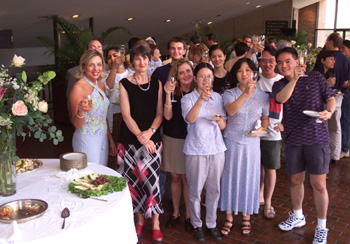
Brigid L.M. Hogan, Ph.D., was honored at a reception last week for her recent induction in the Royal Society. Students and co-workers toasted Hogan, Hortense B. Ingram Professor of Molecular Oncology and Howard Hughes Medical Institute investigator. (photo by Anne Rayner)
Speaker urges frank talk about pregnancy
Preaching abstinence to adolescents is ineffective, said the publisher of “The Women’s Health Letter,” at a lecture last week during the Lonnie S. Burnett Vanderbilt Ob-Gyn Society. But speaking frankly about money, specifically the difference in salaries between a college graduate and a high school dropout, will get their attention.
“If you can point out to a would-be teen mother, that if she’s younger than 19 and has never graduated from high school, she’s committing herself to a low income, she’ll listen,” said Dr. Alvin F. Goldfarb, professor of Obstetrics and Gynecology at Jefferson Medical College in Philadelphia. Goldfarb is a 1947 graduate of Vanderbilt University School of Medicine and the Burnett Society’s 2001 distinguished alumnus. “If she’s 20 to 24 with no college, her income may be $24,000. If she’s older than 25 and has graduated college and no pregnancies before she’s 25, she’s looking at $36,400. If you talk to an adolescent girl about money, she’ll think twice about being sexually active and getting pregnant.”
Goldfarb was one of several members of the society who spoke during the two-day event. The Burnett Society was founded in 1989 as The Vanderbilt Ob-Gyn Society Stork Club. It was renamed The Lonnie S. Burnett Ob-Gyn Society in 1993 to honor Burnett, the Frances and John C. Burch Professor of Obstetrics and Gynecology and former chairman of the Department of Obstetrics and Gynecology.
Goldfarb said that female adolescent patients are “the forgotten women,” a group of patients rarely talked about and with few specialists to treat them. About 80 percent of all young adults have had at least one sexual experience by the 12th grade, so any adolescent girl over the age of 8 should know about contraception, Goldfarb said.
By age 14, the conversation should become more frank.
“They need to know about consequences, not about what their mother is going to say, but that these decisions are going to influence their future,” Goldfarb said.
“That’s the scary part – when young men and women decide to engage in sexual activity before the age of 15, they will have a minimum of four to five partners by the time they are 25. That’s a very, very scary problem from a public health standpoint,” he said.
“We’ve got to get the point across that we’re not here to condemn or condone,” he told the group of obstetrician-gynecologists. “But we’re here to help these young adults make the right decisions. Whether we like it or not, adolescent sexuality is here to stay. The best we can do is give good information to keep adolescents from developing the problems of unintended pregnancy and sexually transmitted diseases. But we need to remain non-judgmental.”













